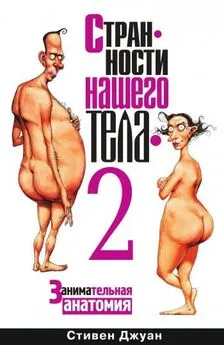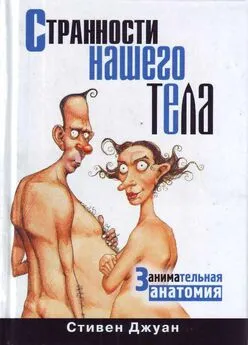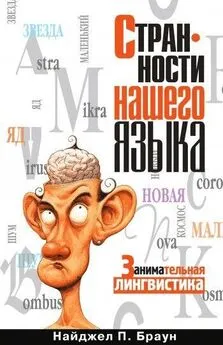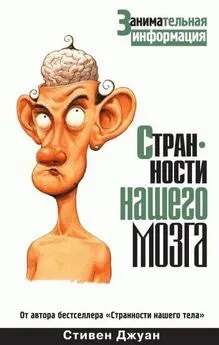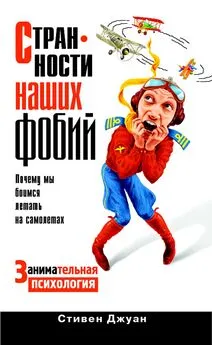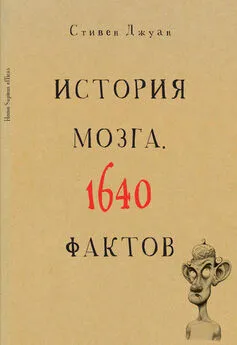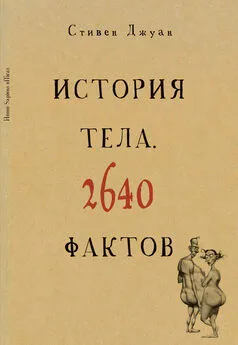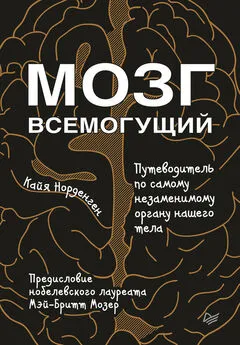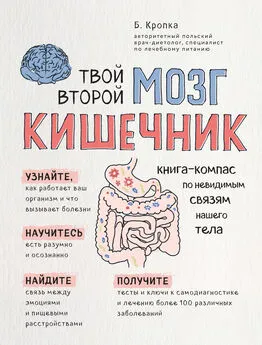Стивен Джуан - Странности нашего тела – 2
- Название:Странности нашего тела – 2
- Автор:
- Жанр:
- Издательство:Литагент «РИПОЛ»15e304c3-8310-102d-9ab1-2309c0a91052
- Год:2009
- Город:Москва
- ISBN:978-5-386-01642-5
- Рейтинг:
- Избранное:Добавить в избранное
-
Отзывы:
-
Ваша оценка:
Стивен Джуан - Странности нашего тела – 2 краткое содержание
Автор «Странностей нашего тела», австралийский чародей «странностей» – Стивен Джуан снова к вашим услугам. Он как всегда готов отвечать на все ваши вопросы; приводить факты – от тех, что находятся на слуху, до самых удивительных и неожиданных; рассеивать ваши стойкие заблуждения по поводу всего, что касается ЧЕЛОВЕКА – от рождения до смерти и от макушки до кончиков пальцев на ногах.
Стивен Джуан расскажет вам все, что вы хотите узнать о странностях Вашего тела, точнее – всё то, о чем не успел рассказать в своей первой книге.
Странности нашего тела – 2 - читать онлайн бесплатно ознакомительный отрывок
Интервал:
Закладка:
29. Sterling T. Scientists figure out why Mona Lisa smiles // Associated Press. 15 December 2005.
30. Ekman P. Emotions Revealed: Recognising Faces and Feelings to Improve Communication and Emotional Life. N. Y.: Henry Holt. 2004.
31. Juan S. Is it possible to ‘read’ a person’s face? // National Post (Toronto). 28 November 2005. Body & Health. P. 1.
32. Juan S. Why do they call plastic surgery «plastic»? // National Post (Toronto). 19 December 2005. Body & Health. P. 1–2.
33. Juan S. Synthetic people // Sun-Herald (Sydney). 2 May 1999. Tempo. P. 16.
34. Juan S. What is the Pinocchio effect? // New York Daily News. 2 August 2005. Body Work. P. 1–2.
35. Juan S. What is the Pinocchio effect? // National Post (Toronto). 22 August 2005. Body & Health. P. 1–2.
Глава 3
1. Apple D. and Rabb M. Ocular Pathology (5 thed.). St Louis: Mosby, 1998.
2. Доктор Дэвид Дж. Эппл работает в центре Морана Университета медико-санитарных дисциплин в Солт-Лейк-Сити (Юта, США).
3. Coulombre A. The role of intraocular pressure in the development of the chick eye // Journal of Experimental Zoology, 1956. Vol. 133. P. 211–225.
4. Goss R. The Physiology of Growth. N. Y.: Academic Press, 1978. P. 191–199.
5. Juan S. Do my eyeballs remain the same size from birth? // National Post (Toronto). 22 August 2005. Body & Health. P. 2.
6. Adler’s Physiology of the Eye (10 thed.) / Moses R. and Hart W. St Louis: Mosby, 2003.
7. Juan S. The eyes have it // New York Daily News. 8 September 2004. Body Work. P. 2.
8. Доктор Том Стикел работает на факультете оптометрии университета Индианы в Блумингтоне (США).
9. Schwartz S. Visual Perception: A Clinical Orientation. Connecticut, Norwalk: Appleton & Lange, 1994.
10. Juan S. How long does it take to damage your eyes when you stare at the sun? // National Post (Toronto). 11 October 2005. Body & Health. P. 1–2.
11. Доктор Джон Моренски работает на факультете нейрохирургии университета Миссури в Колумбии (США).
12. Juan S. Why do I sometimes visualize a glowing green or yellow 'eye' after rubbing my eyes? // National Post (Toronto). 16 January 2006. Body & Health. P. 1–2.
13. Lessard N., Pare M., Lepore F. and Lassonde M. Earlyblind human subjects localize sound souces better than sighted subjects // Nature, 1998. Vol. 395. P. 278–280.
14. Lessard N., Lepore F., Villemagne J. and Lassonde M. Sound localization in callosal agenesis and early callosotomy subjects: Brain reorganization and compensatory strategies // Brain, 2002. Vol. 125. P. 1039–1053.
15. Pallarito K. Early blindness sharpens sense of sound // Daily Health and Medical News. 18 August 2004.
16. Wuensch K., Chia R., Castellow W., Chuang С. and Cheng B. Effects of physical attractiveness, sex, and type of crime on mock juror decisions: A replication with Chinese students // Journal of Cross-Cultural Psychology, 1993. Vol. 24. P. 414–427.
17. Wuensch K. and Moore C. Effects of physical attractiveness on evaluations of a male employee’s allegations of sexual harassment by his female employer // Journal of Social Psychology, 2004. Vol. 144. P. 207–211.
18. Докторá Д. Абвендер и К. Хаф работают на факультете психологии Государственного нью-йоркского университета Брокпорта.
19. Abwender D. and Hough K. Interactive effects of characteristics of defendant and mock juror on US participants'judgment and sentencing recommendations // Journal of Social Psychology, 2001. Vol. 141. P. 603–615.
20. Juan S. Unique eye-dentity // New York Daily News. 5 April 2005. Body Work. P. 1.
21. Juan S. Iris, retina hold keys to eye-dentification // National Post (Toronto). 9 May 2005. Body & Health. P. 1.
22. Juan S. How does peripheral vision work? // National Post (Toronto). 24 October 2005. Body & Health. P. 2.
23. Доктор Том Вильсон – патолог онкологического отделения медицинской школы Университета Вашингтона в Сент-Луисе (Миссури, США).
24. Heydt R. von der. Image parsing mechanisms of the visual cortex // J. Werner and L. Calupa. The Visual Neurosciences, MIT Press, Cambridge, Massachusetts, 2003. P. 1139–1150.
25. Sheldrake R. The Sense of Being Stared. N. Y.: Three Rivers Press, 2003.
26. Rosenthal G., Soper B., Folse E. and Whipple G. Ability to detect covert observations // Perceptual & Motor Skills, 1997. Vol. 85. P. 75.
27. Докторá К. М. Кук и М. А. Персингер работают на кафедре неврологии Лаврентийского университета в Онтарио (Канада).
28. Cook C. and Persinger M. Experimental induction of the 'sensed presence' in normal subjects and an exceptional subject // Perceptual & Motor Skills, 1997. Vol. 85. P. 683.
29. Juan S. Do supermarkets hypnotize you to shop? // National Post (Toronto). 12 December 2005. Body & Health. P. 1–2.
30. Juan S. The ghost in the machine // New York Daily News. 28 September 2004. Body Work. P. 2.
Глава 4
1. Juan S. The psychology of smell // Sun-Herald (Sydney). 4 April 1999. Tempo. P. 13.
2. Интервью, 12 марта 1999.
3. Juan S. Can the smell in a supermarket affect consumer spending? // National Post (Toronto). 11 October 2005. Body & Health. P. 2.
4. Juan S. Cinnamon buns take the cake with smell // National Post (Toronto). 17 October 2005. Body & Health. P. 1–2.
5. Доктор Р. Джеймс Свансон работает на кафедре биологических наук, акушерства и гинекологии университета в Норфолке (Вирджиния, США).
6. Juan S. Cat hair has no effect on nasal hair // National Post (Toronto). 9 January 2006. Body & Health. P. 1.
7. Carlos Padilla is from the University Clinic at the University of Texas Health Science Center in Austin.
8. Juan S. Can the cold cause a cold? // National Post (Toronto). 14 March 2005. Body & Health. P. 1–2.
9. Juan S. What is the Pinocchio effect? // New York Daily News. 2 August 2005. Body Work. P. 1–2.
10. Доктор Алан Хирш изучает проблемы обоняния и вкуса и работает в Чикаго.
11. Juan S. What is the Pinocchio effect? // National Post (Toronto). 22 August 2005. Body & Health. P. 1–2.
12. Wessner C. FYI // Popular Science. January 2000. P. 83.
13. Mitchell S. Food idiosyncrasies: Beetroot and asparagus // Drug Metabolism and Disposition, 2001. Vol. 29. No. 4 (pt 2). P. 539–543.
14. Matluk A. Scent of a man // New Scientist. 10 February 2001. P. 34–38.
15. Juan S. How important is histocompatibility (compatible immune systems) in human mating? // New York Daily News. 6 December 2005. Body Work. P. 1–2.
16. Juan S. Sniffing out an ideal mate // National Post (Toronto). 2 January 2005. Body & Health. P. 1–2.
17. Juan S. Why do they call it ‘hay fever’? // National Post (Toronto). 31 October 2005. Body & Health. P. 2.
Глава 5
1. Juan S. Why can’t I wiggle my ears? // National Post (Toronto). 14 March 2005. Body & Health. P. 1.
2. Juan S. Sifting through the din // National Post (Toronto). 19 September 2005. Body & Health. P. 1.
3. Доктор Ллойд Трипп – психолог кафедры экспериментальной психологии в университете Цинциннати (Огайо, США).
4. Juan S. Staying vertical // New York Daily News. 2 February 2005. Body Work. P. 1.
5. Juan S. Why can’t humans hear radio waves? // National Post (Toronto). 11 October 2005. Body & Health. P. 2.
6. Доктор Андреа Зардетто-Смит работает на факультете физиотерапии и медико-биологических наук Крейтонского университета в Омахе (Небраска, США).
7. Bear M., Connors B. and Paradiso M. Neuroscience: Exploring the Brain. Baltimore, Maryland: William and Wilkins, 1996.
8. Hofman P., Riswick J. Van and Opstal A.Van. Relearning sound localization with new ears // Nature Neuroscience, 1998. Vol. 1. No. 5. P. 417–421.
9. Salvi R. An inescapable buzz // Discover. October 1995. P. 28.
10. Juan S. Synthetic people // Sun-Herald (Sydney).
2 May 1999. Tempo. P. 16.
Глава 6
1. Доктор Ричард Уайзман – психолог, работает в университете Херфордшира (Великобритания).
2. Juan S. Only when I laugh // Sun-Herald (Sydney).
3 October 1999. Tempo. P. 14.
3. Доктор Чарлз Б. Симпсон работает в отделении отоларингологии в медицинском центре университета Техаса в Сан-Антонио.
4. Juan S. Voices of the people // New York Daily News. 21 July 2004. Body Work. P. 2.
5. Kucik C., Martin G. and Sortor B. Common intestinal parasites // American Family Physician, 2004. Vol. 69. No. 5. P. 1161–1168.
6. Доктор Т. Дж. Уилкинсон – химик и судмедэксперт, работает в отделе общей химии и судмедэкспертизы Национальной лаборатории Лоуренса в Беркли (Калифорния, США).
7. Juan S. Do lips have prints? // New York Daily News. 16 February 2005. Body Work. P. 1.
8. Juan S. Do lips have prints? // National Post (Toronto). 11 March 2005. Body & Health. P. 1.
9. Интервью, 13 января 2005.
10. Clayton C. Pyjamarama: Sleepover Handbook. L., Bloomsbury, 1996.
11. Juan S. The things people do in the night // National Post (Toronto). 11 July 2005. Body & Health. P. 1–2.
12. Hans M., Nelson S., Pracharktam N., Baek S., Strohl K. and Redline S. Subgrouping persons with snoring and/or apnea by using anthropometric and cephalometric measures // Sleep and Breathing, 2001. Vol. 5. No. 2. P. 79–91.
13. Juan S. What is snoring and why do people who snore not hear their own snoring and wake up? // National Post (Toronto). 16 January 2006. Body & Health. P. 1.
14. Juan S. It’s all a matter of taste // New York Daily News. 19 April 2005. Body Work. P. 1.
15. Доктор Видья Балодиа работает на кафедре неврологии Университета Вашингтона в Сент-Луисе (Миссури, США).
16. Waddell P. Burning question. New Scientist. 16 December 1995. P. 65.
17. Докторá Теодор Левин и Майкл Эдгертон работают в Висконсинском университете в Мэдисоне (США).
18. Lalakea M. and Messner A. Ankyloglossia: Does it matter? // Pediatric Clinics of North America, 2003. Vol. 50. No. 2. P. 381–397.
19. Juan S. It’s not just a matter of taste // New York Daily News. 25 August 2004. Body Work. P. 2.
20. Kupietzky A. and Botzer E. Ankyloglossia in the infant and young child: Clinical suggestions for diagnosis and management // Pediatric Dentistry, 2005. Vol. 27. P. 40–46.
Читать дальшеИнтервал:
Закладка:
